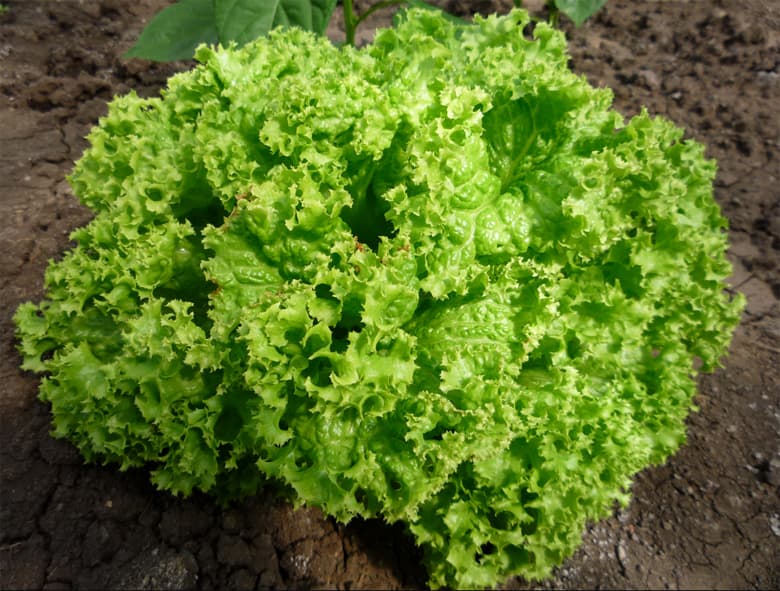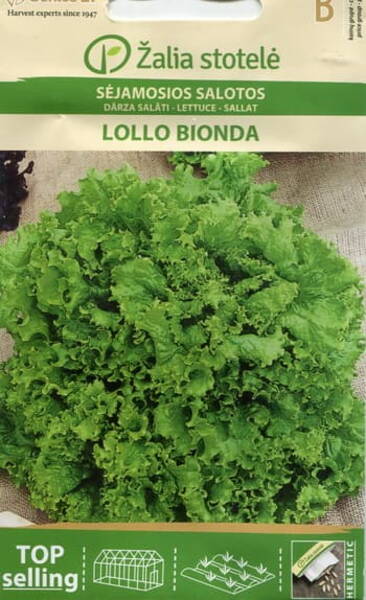The lettuce is early ripe, the crop can be harvested 50-63 days after germination. It has delicate, corrugated, very decorative green leaves.
Forms a loose head, 15-20 cm in diameter. The variety is resistant to bolting. Suitable for year-round cultivation in open ground and in greenhouses.
1.0 g = 800-1200 seeds.

* Preparing lettuce seeds for sowing.
No special treatment of lettuce seeds is carried out before sowing.
Attention! Seed germination lasts up to 4 years.
Before sowing, watercress seeds can be soaked for 12 hours in a damp cloth.
Lettuce seeds are small, and to avoid thickening the crops, they are mixed with sawdust or sand. This also helps reduce seed consumption.
Growing seedlings.
The seedling method allows you to get a salad from the open ground at an earlier date. Seedlings are grown in seed boxes filled with a mixture of turf soil and humus (1:1).
Seeds are sown in rows, leaving 1.5-2 cm between rows. Seed consumption per box is about 1 g. Seeds germinate well at a temperature of +22+25°C. Seedlings are grown without picking. The seedlings are thinned out, leaving a distance of 2 cm between the plants. In the phase of three to four true leaves, the seedlings are planted in the ground.
Some gardeners prefer to grow seedlings with picks. In this case, the seeds are sown in boxes in the usual way (0.4-0.5 g per 1 sq. m, planting depth 0.5 cm).
When growing seedlings, you must constantly ensure that the plants receive enough light, otherwise, they will become very elongated. After 2-3 weeks, the seedlings are planted in peat pots or any other containers with a nutrient mixture.
Attention! Headed and half-headed varieties must be planted as seedlings, as this allows one to obtain full-fledged heads of cabbage. The seedling method is needed for both early and late plantings. When sowing seeds on April 5-10 in a greenhouse, by May 5-10 the seedlings have four to five leaves. The sowing rate for lettuce seeds is 0.3-0.4 g/m2, the sowing pattern is 15x5 cm, planting depth is 1 cm. After sowing, the soil is slightly compacted. After 8-9 days, shoots appear, and after 30-35 days the seedlings are ready for planting. Sowings of head lettuces are thinned out by 15-25 cm, depending on the early maturity of the variety.
Preparing the site and sowing seeds in the ground.
Lettuce is an early ripening crop that appears on the table as one of the first in the spring. It is cold-resistant and can be sown before winter. Mass germination of seeds begins at +4°C. The favourable temperature for plant growth and development is +10+17°C. In hot, dry weather, lettuce shoots quickly and produces virtually no marketable products. It is quite demanding on soil and air moisture.
Attention! Excessive humidity promotes the spread of fungal diseases and reduces the quality of the crop!
Lettuce, like all fast-growing crops, is demanding soil fertility. The best fertilizer for it is rotted manure, which is applied in early autumn (September), or humus (compost). Apply 4-5 kg per 1 square meter to the site. m. From mineral fertilizers, nitrophoska is added (60-70 g each).
Lettuce does not grow in acidic soils. By the way, lettuce can serve as an indicator by which the acidity of the soil is determined. It is preferable to grow lettuce in well-cultivated neutral soils (pH 6.8-7.2).
The soil should be loose and moderately moist. For lettuce, soils with a neutral reaction are best, but it can also grow in slightly acidic soils with sufficient nutrients. On acidic soils, careful liming is necessary.
The salad is placed after cucumbers, early potatoes, cabbage and tomatoes, under which high doses of organic fertilizers were applied. Before sowing, it is also good to add manure or humus in the amount of 2-3 kg per 1 square meter. m. This will significantly increase the yield.
In addition, leaf and head lettuce are grown in open and protected ground not only as independent crops but also as compactors. Sow seeds in multi-line ribbons at a distance of 40-50 cm from each other, the distance between rows in the ribbon is 15-20 cm. Per 1 sq.m requires 0.6 g of leaf lettuce seeds and 0.3 g of head lettuce.
Small-headed, early-ripening lettuces are placed according to a pattern of 20x20 cm, and large-headed ones - 30x30 cm. To always have fresh greens, leafy lettuces are sown in open ground throughout the summer (from mid-April to the end of August).
Leaf lettuce produces edible leaves within 30-40 days after germination. It is usually sown in rows with a distance of 10-15 cm between them and 5-6 cm between plants. Sow at a depth of 0.5-1.0 cm. The seeding rate is 0.5 g per 1 sq. m. m.
In summer, late varieties resistant to bolting are sown. To extend the time for obtaining greens, leaf lettuces are sown after 15-20 days, head lettuces - 2-3 times per season, three varieties at a time (early, middle, late).
Seedlings are planted in a permanent place with a distance between plants of 20-25 cm. For asparagus salad, the intervals between rows are 50-60 cm, and in a row 25-30 cm. The size of row spacing and the frequency of placing plants in rows varies significantly depending on the variety and the size of the rosette leaves.
Care, watering and fertilizing.
The row spacing in the salad beds is kept loose and free of weeds. Water as needed. Typically, lettuce is thinned 2-3 times: in the phase of 2-3 true leaves and in the phase of 5-7 leaves. Thinned plants are eaten.
Lettuce benefits from nitrogen-potassium fertilizing.
Harvesting and storage.
Leaf lettuces are harvested as needed or a one-time harvest is carried out with the removal of all plants. Head lettuce is removed as the heads form.
Leaf lettuces are ready to eat in 25-30 days, and head lettuces in 45-70 days, depending on the variety. Leaf lettuces are harvested when 6-10 leaves appear, and cabbage lettuces - when heads with a diameter of 5-12 cm are formed.
When harvesting, the heads of cabbage are cut off with a sharp knife close to the ground, and yellow and wilted leaves are removed. It is better to remove the salad early in the morning or in the evening. If the products cannot be used immediately (all salads, except asparagus, do not store well), the plants are dug up with a clod of earth and stored that way.
Lettuce harvesting begins when the plants form a rosette of leaves or a head, but not later than the appearance of the stem in individual plants. Headed varieties are harvested in dry weather. On a hot day or after rain, you cannot harvest the lettuce, as in this case it quickly loses quality and rots.
At normal room temperature, leaf lettuce lasts no more than a day, and head lettuce - no more than three to four days. Lettuce can be stored in plastic bags without loss of nutritional value for three to four weeks. Leaves (leafy varieties) and heads of cabbage (headed varieties) are eaten raw, before the flower shoot forms, since with its appearance the leaves become bitter.












